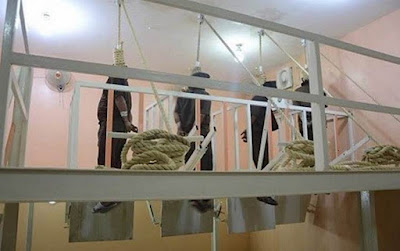 |
| Drawing crowds: The last public hanging in Kentucky, August 14, 1936 |
Since the nineteenth century, American elites have searched for a mode of execution that was professional in appearance and humane in practice, one that would display the state’s sober-minded restraint while taking life as quickly and painlessly as possible.
As early as the 1830s, states began searching for ways to take the condemned out of this world with as little fanfare and medieval ritual as possible. Worried about jeering execution day crowds, elites moved executions behind walls and eventually into the bowels of prisons where sober decorum would prevail.
A complex division of tasks within the execution chamber, moreover, cleansed the punishment of vengeful overtones.
The “law” was no longer a local sheriff publicly carrying out a hanging on behalf of an aggrieved community, but multiple bureaucrats, each responsible for performing a small step in a highly-choreographed procedure. One tied the hands, another bound the feet, another secured the noose, and another pulled the lever to release the trap door. No single person embodied the state.
And since the 1890s, a persistent dark optimism has produced revolutions in killing technologies every few decades.
From shooting and hanging to electrocuting to gassing to injecting, Americans have continuously introduced new killing technologies that have promised to minimize the discomfort, for witnesses and the condemned, caused by the state’s exercise of its sovereign power over life and death.
With lethal injections, first used by Texas in 1982 and gradually adopted by every other state with the death penalty, Americans thought they had finally arrived at a perfect solution.
What could better project an aura of professional competence and dignified restraint than an execution in which the condemned person looked like a patient being put to sleep for an operation?
But it hasn’t always gone that way. Officials sometimes have trouble accessing inmates' veins. In 2009, Ohio officials spent two hours unsuccessfully trying to establish an IV line into Romell Broom
before giving up. Broom left the execution chamber alive, his body punctured in eighteen different sites by failed attempts to find a vein.
And last year, Oklahoma technicians incorrectly inserted the needle into Clayton Lockett’s groin, missing his vein and releasing the drugs into the surrounding tissue. After being declared unconscious, Lockett began writhing and attempted to sit up. He
died of a heart attack 43 minutes after the execution began and seven minutes after rattled officials tried to abort it.
In response to incidents like these, attorneys for condemned inmates have launched a
new legal attack on lethal injection.
Source: The Conversation, Daniel LaChance, April 8, 2015. Daniel LaChance is an Assistant Professor of History at Emory University.


.jpg)







